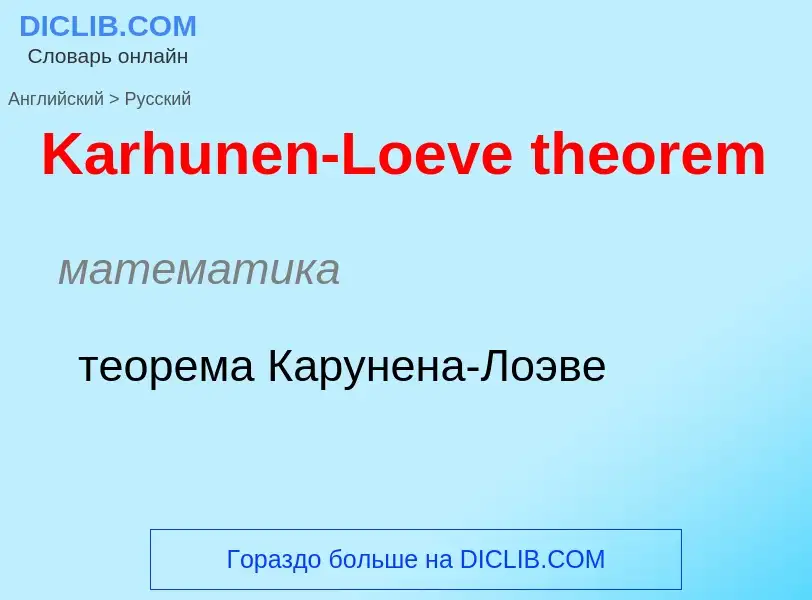Перевод и анализ слов искусственным интеллектом ChatGPT
На этой странице Вы можете получить подробный анализ слова или словосочетания, произведенный с помощью лучшей на сегодняшний день технологии искусственного интеллекта:
- как употребляется слово
- частота употребления
- используется оно чаще в устной или письменной речи
- варианты перевода слова
- примеры употребления (несколько фраз с переводом)
- этимология
Karhunen-Loeve theorem - перевод на русский
математика
теорема Карунена-Лоэве
математика
теорема о дивергенции
теорема Гаусса-Остроградского
математика
формальная теорема
Определение
Википедия
In the theory of stochastic processes, the Karhunen–Loève theorem (named after Kari Karhunen and Michel Loève), also known as the Kosambi–Karhunen–Loève theorem states that a stochastic process can be represented as an infinite linear combination of orthogonal functions, analogous to a Fourier series representation of a function on a bounded interval. The transformation is also known as Hotelling transform and eigenvector transform, and is closely related to principal component analysis (PCA) technique widely used in image processing and in data analysis in many fields.
Stochastic processes given by infinite series of this form were first considered by Damodar Dharmananda Kosambi. There exist many such expansions of a stochastic process: if the process is indexed over [a, b], any orthonormal basis of L2([a, b]) yields an expansion thereof in that form. The importance of the Karhunen–Loève theorem is that it yields the best such basis in the sense that it minimizes the total mean squared error.
In contrast to a Fourier series where the coefficients are fixed numbers and the expansion basis consists of sinusoidal functions (that is, sine and cosine functions), the coefficients in the Karhunen–Loève theorem are random variables and the expansion basis depends on the process. In fact, the orthogonal basis functions used in this representation are determined by the covariance function of the process. One can think that the Karhunen–Loève transform adapts to the process in order to produce the best possible basis for its expansion.
In the case of a centered stochastic process {Xt}t ∈ [a, b] (centered means E[Xt] = 0 for all t ∈ [a, b]) satisfying a technical continuity condition, X admits a decomposition
where Zk are pairwise uncorrelated random variables and the functions ek are continuous real-valued functions on [a, b] that are pairwise orthogonal in L2([a, b]). It is therefore sometimes said that the expansion is bi-orthogonal since the random coefficients Zk are orthogonal in the probability space while the deterministic functions ek are orthogonal in the time domain. The general case of a process Xt that is not centered can be brought back to the case of a centered process by considering Xt − E[Xt] which is a centered process.
Moreover, if the process is Gaussian, then the random variables Zk are Gaussian and stochastically independent. This result generalizes the Karhunen–Loève transform. An important example of a centered real stochastic process on [0, 1] is the Wiener process; the Karhunen–Loève theorem can be used to provide a canonical orthogonal representation for it. In this case the expansion consists of sinusoidal functions.
The above expansion into uncorrelated random variables is also known as the Karhunen–Loève expansion or Karhunen–Loève decomposition. The empirical version (i.e., with the coefficients computed from a sample) is known as the Karhunen–Loève transform (KLT), principal component analysis, proper orthogonal decomposition (POD), empirical orthogonal functions (a term used in meteorology and geophysics), or the Hotelling transform.





![universality]]) resembles the [[Mandelbrot set]]. universality]]) resembles the [[Mandelbrot set]].](https://commons.wikimedia.org/wiki/Special:FilePath/CollatzFractal.png?width=200)
